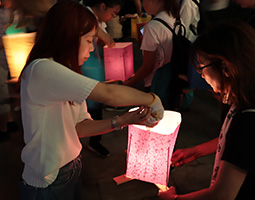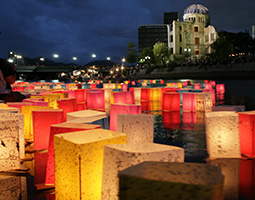July 2022
- English
- 日本語
Floating Lanterns: Messages for Peace

Lanterns carrying messages for peace 
People carrying lanterns prepare to send them into the river

Young volunteers lighting lanterns 
Lanterns float down the Motoyasu River near the Hiroshima Peace Memorial (Genbaku Dome), a UNESCO World Heritage Site

The Floating Lanterns – Messages for Peace event is held in Hiroshima on the evening of August 6 each year. People gather in Hiroshima to pray for peace and float lanterns with personal messages written on them down the river.

Each year, on the evening of August 6, several thousand lanterns are floated on the Motoyasu River that flows by the Hiroshima Peace Memorial (Genbaku Dome) (see box article), a UNESCO World Heritage Site in the Peace Memorial Park in Hiroshima.
A fire is lit within the box-shaped lanterns, which are made by pasting paper to a wooden frame. This is a summer tradition in Hiroshima, an event known as the Floating Lanterns – Messages for Peace. The gently floating lanterns create a dreamy spectacle as the light of each lantern sways back and forth. The event is hosted by the Hiroshima-shi Chuo-bu Shotengai Shinko Kumiai Rengokai (Hiroshima City Central Area Shopping District Promotion Association), while the entire process from creating the lanterns to selling them and sending them down the river is handled mainly by Hiroshima resident volunteers under the supervision of the Association.
Senior managing director Wakasa Toshiyasu says that “August 6, 1945 is the day when the atomic bomb was dropped on Hiroshima. Many people died in this river that day. Hiroshima’s floating lanterns were started as a memorial service by survivors after the war. So the light of each lantern is the light of life for each person who died.”
In Japan, there has been a summer custom since ancient times known as Obon, in which the souls of ancestors are welcomed into homes and then sent back to the afterlife. In some parts of Japan, spirit boat processions are held in which boats are made for souls to ride on as they are sent back to the afterlife. In the Aki region of western Hiroshima Prefecture, people decorate graves with colorful lanterns during the Obon season. It is said that the floating lanterns in Hiroshima City are a combination of these two customs.

Wakasa says that “originally, the floating lanterns were to commemorate those who had died, but with many visitors from overseas, the lanterns have come to have more of a message of lasting world peace.”
During the lighting ceremony held before the lanterns are sent down the river, the lanterns are lit with flames from the “embers of the atomic bomb”* that rests in Hoshino Village in Fukuoka Prefecture.
Participants can send a lantern directly down the Motoyasu river from the waterfront terrace on the shore opposite the Hiroshima Peace Memorial (Genbaku Dome).**
Since 2015, an Online Floating Lantern event has also been held, mainly by young people. In 2020 and 2021, the in-person floating lantern event was canceled as a precaution against the spread of COVID-19, but messages sent online from all over the world were floated down a virtual online river, and this was displayed on digital signage all over Hiroshima City on August 6, 2021.
Each lantern is a faint hope. But the desires for peace bound in each lantern form thousands of wishes, and the stream of light they create on the Motoyasu River will continue to flow year after year.
* Yamamoto Tatsuo was born in Hoshino Village, a part of Yame City, Fukuoka Prefecture. He brought the embers from the atomic bomb back as a memento of his uncle while searching for him in Hiroshima. He lit his pocket warmer with the lingering flames and took them back home. The embers continue to burn in the Tower of Peace in Hoshino Village.
** Participants will not be able to send off lanterns on their own from the water access terrace in 2022 as a measure against COVID-19. Messages will be collected and sent off by the sponsor instead.
Hiroshima Peace Memorial (Genbaku Dome)

The Hiroshima Peace Memorial (Genbaku Dome) was originally the Hiroshima Prefectural Industrial Promotion Hall, completed in 1915. On August 6, 1945, the entire building was set ablaze by the detonation of an atomic bomb only about 160 meters away from the blast center, and most of the building collapsed. The building came to be called Genbaku Dome by city residents in reference to the elliptical dome on the top of the building that did not collapse.
The Peace Memorial Park was built in 1955 to wish for lasting worldwide peace. Within the park is the Hiroshima Peace Memorial (Genbaku Dome), the Hiroshima Peace Memorial Museum, and the Hiroshima National Peace Memorial Hall for the Atomic Bomb Victims, among other facilities.

